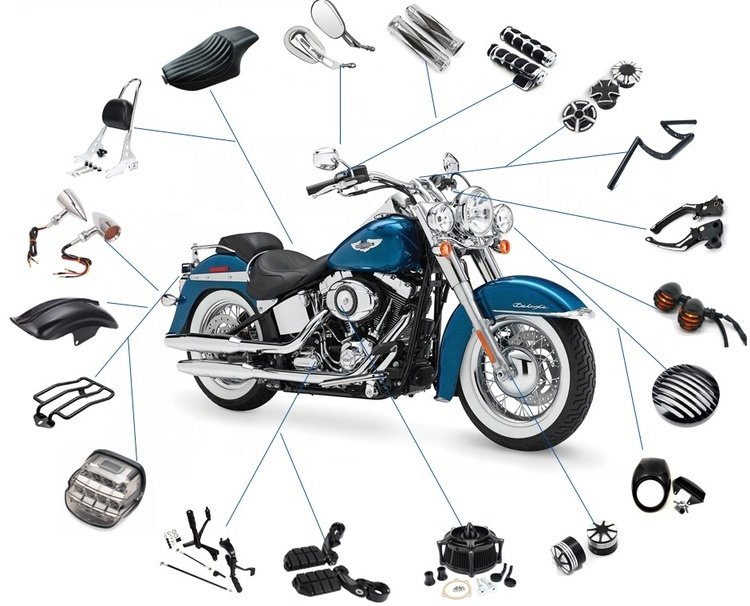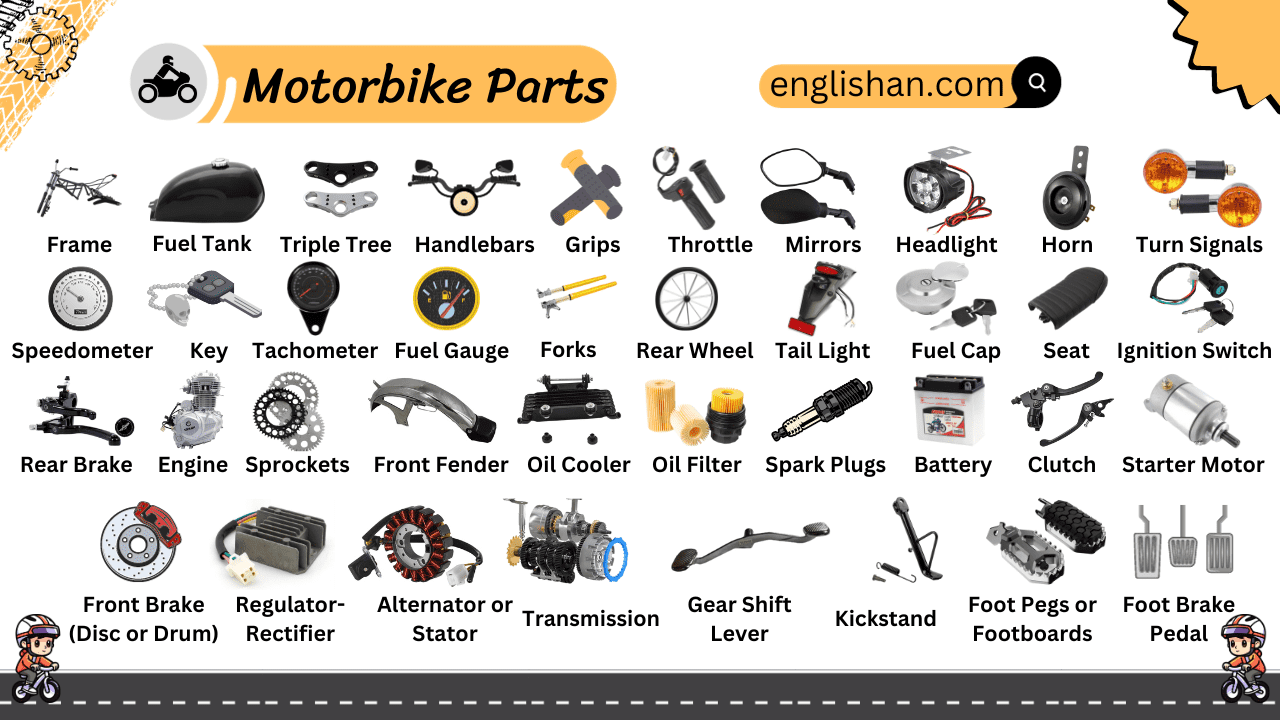The Ultimate Guide to Essential Bike Parts Wellington and Their Functions
A Comprehensive Guide to Selecting the most effective Bike Components for Your Ride
Selecting the best bike parts is essential for any cyclist. Each component plays a significant role in enhancing performance and comfort. Comprehending the kind of bike and its designated use is essential. From handlebars to tires, every detail matters. This guide will explore the important elements of selecting these components. The best choices can elevate any ride, but what specific factors should one consider to achieve the most effective outcomes?
Recognizing Bike Kinds and Their Elements
Just how can one pick the ideal bike components without understanding the different types of bicycles? Each bicycle type-- mountain, roadway, hybrid, and cruiser-- attributes special elements customized to its particular function. Mountain bicycle, as an example, are geared up with robust structures and broader tires for off-road stability, while roadway bikes focus on lightweight products and aerodynamic layouts for rate on paved surfaces.Hybrids mix aspects from both hill and roadway bikes, offering versatility for diverse terrains. Cruisers, designed for convenience, feature bigger seats and handlebars for a much more unwinded riding placement. Each type additionally uses distinctive gear systems, brakes, and wheels that accommodate their designated use.Understanding these distinctions is crucial for choosing reliable and compatible bike components. A rider's selection can notably boost performance, security, and overall pleasure. By identifying the qualities of each bike type, one can make educated choices when upgrading or replacing parts.
Key Considerations for Finding Handlebars
When choosing handlebars, a cyclist must think about various factors that can substantially impact comfort and control. One primary consideration is the width of the handlebars, as it influences stability and take advantage of during rides. Broader handlebars normally offer much better control, specifically in technological surfaces, while narrower ones might improve the rules of aerodynamics for racing.Additionally, the rise or decrease of the handlebars impacts the cyclist's posture. Higher handlebars promote a much more upright setting, lowering pressure on the back, while lower ones can boost the rules of aerodynamics. The shape of the handlebars is also important; options like flat, riser, or drop bars provide to various riding designs and preferences.Material is one more crucial element, with aluminum and carbon fiber being popular for their equilibrium of weight and longevity. Inevitably, the appropriate handlebars should align with the cyclist's planned usage, making certain a enjoyable and reliable cycling experience.
Picking the Right Saddle for Convenience and Performance
Choosing the right saddle is essential for optimizing comfort and performance throughout experiences. An appropriate saddle can considerably influence a cyclist's experience, straight influencing energy degrees and overall satisfaction. When selecting a saddle, factors such as size, shape, and extra padding need to be meticulously thought about. The saddle's width have to line up with the rider's rest bone measurements, ensuring ample support. In addition, cushioning choices vary amongst bikers; some might like minimal cushioning for a more straight connection to the bike, while others may seek luxurious cushioning for boosted comfort on longer experiences. Saddle shape likewise plays an important duty, as it affects the circulation of stress during pedaling. Materials made use of in construction can affect weight and longevity. Ultimately, checking various saddles is vital, as individual comfort varies substantially. A thoughtful approach to saddle choice can cause better performance and a much more pleasurable biking experience.
The Value of Top Quality Tires for Different Terrains
Choosing the appropriate tires is important for suitable efficiency across numerous surfaces. Different surfaces demand particular tire functions, such as walk patterns and rubber substances, to assure grip and durability. Furthermore, the durability and durability of tires can substantially affect a biker's overall experience and safety on the road or trail.

Terrain-Specific Tire Includes
Just how does the surface influence tire performance? Different terrains require distinct tire features to enhance performance and security. For circumstances, hill cycling on rocky tracks demands tires with aggressive walk patterns to offer hold and stability. Alternatively, roadway cycling on smooth surfaces benefits from narrower tires that minimize rolling resistance.In wet or sloppy conditions, tires developed with deeper grooves can direct water efficiently, avoiding hydroplaning. Additionally, softer compounds might boost traction on slick surface areas, while harder compounds offer durability on harsh courses. Comprehending these terrain-specific tire features is vital for bikers intending to improve their riding experience. Selecting the appropriate tire not just effects dealing with but additionally general comfort, making it essential for cyclists to match their tires to their designated terrain.
Tire Durability and Efficiency
Quality tires significantly affect a bicyclist's performance and safety and security across various surfaces. The resilience of tires is essential for holding up against the rigors of various surfaces, from sturdy tracks to smooth roads. Greater quality tires usually feature enhanced sidewalls and advanced rubber substances, which enhance their long life and grip. For circumstances, tires developed for off-road problems usually have deeper footsteps that provide much better grip on loose surface areas, while roadway tires prioritize a smoother account for decreased rolling resistance. In wet problems, tires with specialized step patterns can improve handling and minimize the threat of hydroplaning. Ultimately, investing in high quality tires customized to details riding settings can substantially enhance total cycling experience, ensuring both performance and security.
Gearing Equipments: Locating the Perfect Fit for Your Riding Style
While lots of bikers recognize the significance of a great bike framework or wheels, the tailoring system plays an important function in improving efficiency and convenience when traveling or trail. Selecting the reference best gearing system depends mainly on specific riding design and surface. As an example, roadway bikers frequently gain from a small gearing configuration, enabling smoother shifts and higher speeds on flat surfaces. In contrast, hill bicycle riders might favor a larger series of gears to tackle steep climbs up and harsh descents.Cyclists need to likewise think about the number of gears; a 1x system streamlines changing and minimizes weight, while a 2x or 3x system uses adaptability for different terrains. Recognizing gear ratios is vital, as reduced proportions assist in easier pedaling uphill, while greater proportions support speed on level stretches. Inevitably, the best gearing system harmonizes with the cyclist's choices, guaranteeing a reliable and satisfying cycling experience.
Enhancing Your Adventure With the Right Brakes
Choosing the suitable stopping system is as crucial as choosing the appropriate gearing for a bike. The quality and kind of brakes can significantly influence a biker's control, security, and total riding experience. Bicyclists often encounter a choice in between rim brakes and disc brakes. Edge brakes are generally lighter and less complicated to preserve, making them a preferred choice for roadway bikes, while disc brakes provide premium stopping power and efficiency in varied weather, ideal for mtb and touring setups.Moreover, brake pads play a crucial role in stopping efficiency. Selecting the appropriate material-- such as organic, metal, or semi-metallic-- can enhance performance based upon riding conditions and personal preferences. On top of that, proper positioning and normal upkeep of the braking system assurance reliable performance and durability. Inevitably, purchasing the best brakes tailored to specific riding designs can improve safety and pleasure on every adventure.
Updating Accessories for a Better Biking Experience
Updating accessories can greatly improve a biker's experience on the road. Vital safety and security equipment, such as lights and helmets, integrated with comfort improvements like padded seats and ergonomic grips, can make a significant distinction. These upgrades not just boost safety and security but also promote longer and much more pleasurable experiences.
Necessary Safety And Security Equipment
Safety and security equipment is a crucial part of a biker's collection, boosting both defense and convenience on the roadway. Safety helmets are the most important item, significantly decreasing the risk of head injuries in case of a crash. High-visibility apparel and devices, such as reflective vests and lights, ensure that bicyclists remain visible to vehicle drivers, specifically in low-light problems. Gloves provide grasp and lower the probability of blisters, while knee and elbow pads can offer added security during drops. Selecting suitable shoes with a great hold can also boost security while cycling. Purchasing quality safety and security equipment not only advertises a much safer ride but additionally boosts a bicyclist's self-confidence, enabling them to enjoy their cycling experience to the greatest.
Convenience Enhancements and Upgrades
Bikers commonly seek to enhance their riding experience beyond basic security procedures. Convenience enhancements and upgrades play an important duty content in accomplishing this objective. One of one of the most substantial upgrades is a premium saddle, created to offer maximum support and decrease pain throughout longer rides. Furthermore, handlebar grips that use better comfort designs can minimize pressure on hands and wrists. Spending in padded biking shorts can additionally improve convenience by reducing rubbing and stress points. Additionally, shock-absorbing seat posts and broader tires can boost trip top quality by wetting vibrations from rough surface - Motorcycle Spares Christchurch. Finally, changing the bike fit assurances that placements are ideal for private motorcyclists, bring about an extra enjoyable and comfortable cycling experience
Often Asked Concerns
Exactly how Do I Keep My Bike Parts for Long Life?
Keeping bike parts for durability includes routine cleaning, lubrication, and evaluation. Proper storage far from dampness, prompt substitute of worn components, and adherence to producer guidelines can greatly enhance the life-span and efficiency of the bicycle.
What Tools Do I Required for Bike Component Setup?
To set up bike parts properly, one commonly needs essential devices such as wrenches, screwdrivers, tire levers, a multi-tool, and a pump. These tools assist in proper setting up, guaranteeing ideal efficiency and longevity of the bike components.
Exactly how Frequently Should I Change Bike Components?

Can I Mix and Suit Parts From Different Brands?
Blending and matching bike components from various brands is feasible, however compatibility is crucial (Motorcycle Spares Christchurch). Elements like measurements, materials, and style should be thought about to assure peak performance and security, highlighting the value of research study prior to any type of combination
What Are the Signs of Damaged Bike Components?
Signs of damaged bike components include unusual sounds during adventures, decreased efficiency, noticeable damage such as cracks or corrosion, and trouble shifting gears. Routine inspections can help determine these concerns prior to they compromise security and efficiency. Hill bikes, for circumstances, are equipped with robust frames and broader tires for off-road security, while roadway bikes focus on lightweight materials and aerodynamic styles for rate on smooth surfaces.Hybrids mix components from both hill and road bikes, offering flexibility for different surfaces. Alternatively, roadway biking on smooth surface areas advantages from narrower tires that decrease rolling resistance.In wet or muddy conditions, tires designed with deeper grooves can carry water successfully, stopping hydroplaning. Recognizing these terrain-specific tire attributes is essential for bikers intending to improve their riding experience. Tires created for off-road problems normally have much deeper treads that offer much better traction on loose surface areas, while roadway tires focus on a smoother profile for reduced rolling resistance. To install bike parts properly, one commonly calls for necessary devices such as wrenches, screwdrivers, tire levers, a multi-tool, and a pump.